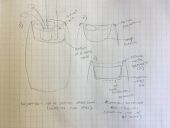Last year (2021) we had a few butternut squash plants grown from South Anna Butternut Squash seed that was bred in Virginia by Edmund Frost for high yields, sweetness and resistance to downy mildew. We are not very talented annual gardeners and I don't really water but we got something like 33 large and medium butternuts off our plants. I had the privilege of working with Edmund and the Common Wealth Seeds team briefly during my commune touring days and I was so happy to buy the seed from the Experimental Farm Network. It's the only vegetable I've ever grown that was an unqualified success. Don't mean to sound like an ad over here, but I really cannot recommend EFN or Common Wealth Seeds highly enough.
Anyway -- then we needed to USE 33 butternut squash. This is my favorite recipe, and one I haven't seen mentioned in the thread yet:
https://40aprons.com/butternut-squash-casserole/
It's not really a lasagna because it's put in all together, not in layers. The pre-cooking on the stovetop then transferring to the oven is a bit fussy for me, but it does turn out amazing. I mostly make it for company, so I haven't dared to experiment very much with just putting it all in the oven right off (after browning just the sausage for food safety), but plan to in the future.
I'm copying the recipe in case the link ever goes dead. Notes in parentheses by me.
Butternut Squash Casserole with Parmesan Breadcrumbs by Jasmine Comer
Rich, savory butternut squash casserole is begging to be part of your holiday dinner. Topped with buttery parmesan breadcrumbs, this mix of butternut squash, sautéed kale, and sweet Italian sausage says autumn in every bite. Make this cozy dish for Thanksgiving dinner or anytime you want to embrace the season.
Prep Time 15 minutes
Cook Time 50 minutes
Total Time 1 hour 5 minutes
Servings 8
Author Jasmine Comer
Equipment
Large skillet
2-quart baking dish
Aluminum Foil
Ingredients
For the Casserole
½ pound sweet Italian sausage
1 tablespoon olive oil (we use a lot more)
1 medium onion sliced (we use 2)
2 tablespoons sage chopped (or whatever herbs are available; I've used sage but also bee balm, fresh Pennsylvania bayberry leaf, oregano, and thyme)
3 cloves garlic minced (we use 4-6)
2 cups kale chopped (I also substitute thawed and drained spinach, beet greens, violets, nettles, or whatever we have around)
¼ cup chicken stock
4 cups butternut squash cubed, approximately 1 ½ pounds total
salt to taste
pepper to taste
For the Breadcrumb Topping
3 tablespoons butter
¾ cup panko breadcrumbs (I've also used regular breadcrumbs I made from stale bread; it doesn't matter)
⅓ cup freshly grated parmesan cheese
1 tablespoon sage chopped
salt to taste
pepper to taste
(I'll also add other fresh herbs we have on hand here like parsley or the others I mentioned above, and if I'm doing that I definitely add the topping to the casserole halfway through instead of at the beginning)
Instructions
Preheat oven to 350° Fahrenheit. Lightly grease baking dish with butter or non-stick cooking spray and set aside.
In large skillet over medium-high heat, cook sausage until browned and crumbled. Drain any liquid that's produced. (I don't drain it but if I did, I'd save it to add back in place of some of the chicken broth.)
Add olive oil to skillet with sausage, then stir in onion slices, cooking 2 to 3 minutes until onions are softened.
Add sage, garlic, kale, and chicken stock to skillet. Sauté everything 2 to 3 minutes, stirring occasionally.
While sausage-kale mixture sautés, place butternut squash cubes in baking dish. Pour sausage-kale mixture over butternut squash and toss or stir everything together to combine. Season with salt and pepper to taste.
Add 3 tablespoons butter to skillet over medium-high heat. Once butter is melted and starts to bubble, stir in panko breadcrumbs and continue stirring until breadcrumbs are golden brown and lightly toasted. (I do NOT bother doing this in the skillet; I microwave the butter and stir it in a bowl. I've also substituted oil. Melting the butter in advance in a hot spot in the kitchen would also work for the microwave-averse.)
Remove skillet from heat and stir in parmesan, sage, salt, and pepper until cheese has melted and ingredients are well combined.
Spread breadcrumb mixture over top of sausage-kale mixture in baking dish. Place in oven and bake approximately 20 minutes. After 20 minutes, cover dish with foil so breadcrumbs don't burn, then return dish to oven and bake 20 more minutes, or until squash is tender. Serve warm. (I add the breadcrumb mixture halfway through instead of bothering with the foil, especially if I'm adding fresh herbs to the topping, so they don't overcook.)
Notes
Make it Vegetarian: Use your favorite meat substitute instead of sausage (or skip the "meat" entirely) and use vegetable stock instead of chicken stock.
Make it Vegan: Use your favorite meat substitute instead of sausage (or skip the "meat" entirely), use vegetable stock instead of chicken stock, and use dairy-free butter and parmesan cheese.
Recipe yields approximately 8 servings. Actual number of servings will depend on your preferred portion sizes.


 We have a hugely overwhelming amount of planning to do -- it will absolutely take the prescribed year -- so if you want to come brainstorm with us you'd be welcome, and I'd also love to come to a meetup wherever it is, although I always seem to be double-scheduled for the coolest things. Where are you at in CT?
We have a hugely overwhelming amount of planning to do -- it will absolutely take the prescribed year -- so if you want to come brainstorm with us you'd be welcome, and I'd also love to come to a meetup wherever it is, although I always seem to be double-scheduled for the coolest things. Where are you at in CT?


